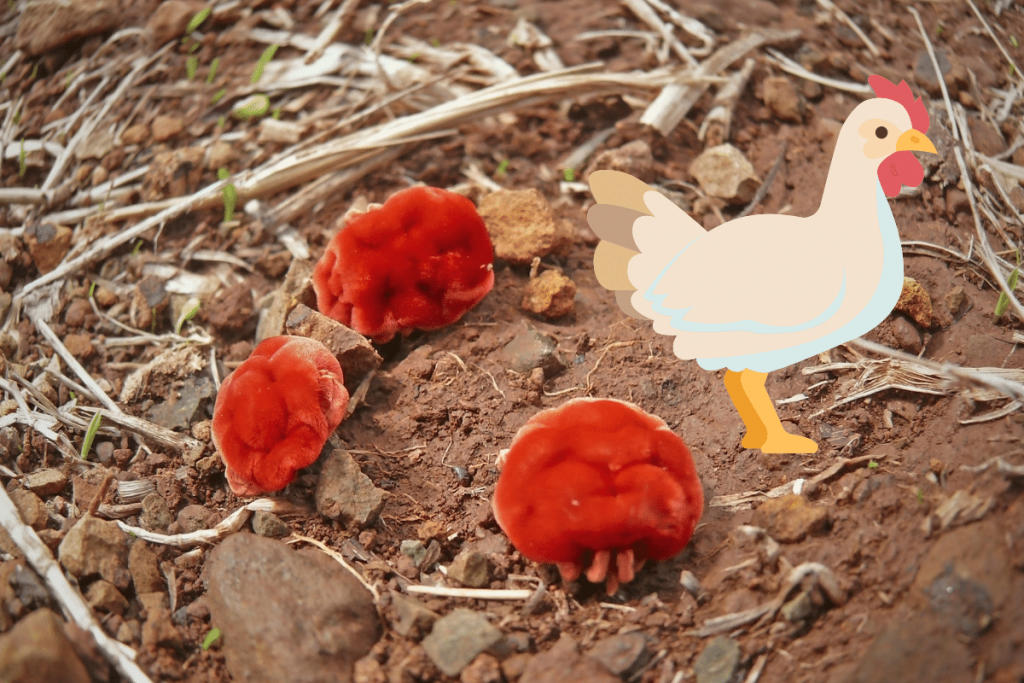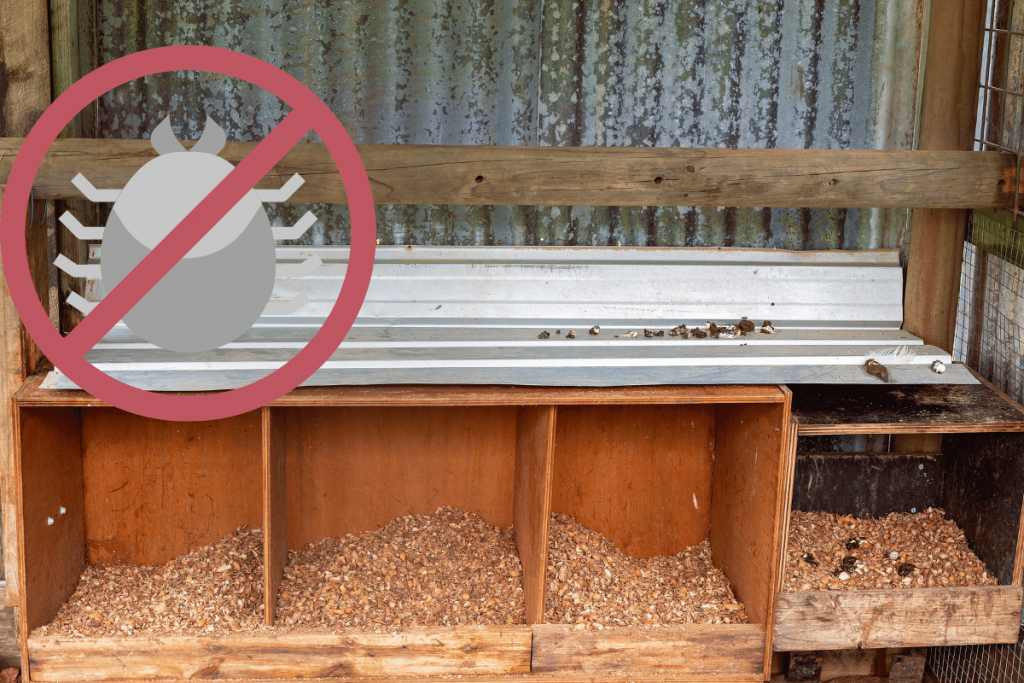One of the most common issues poultry farmers deal with is the presence of chicken mites.
A poultry mite infestation will quickly spread throughout the flock, and if they are not completely eradicated, it might be deadly for the chickens.
Chicken mites are particularly difficult to get rid of because you have to treat the chickens, and the coop needs to be thoroughly cleaned.
Several chemicals and natural remedies are available for removing chicken mites, and it may be challenging to know which one will work best for your flock.
So, does bleach kill chicken mites?
Bleach will kill chicken mites in the coop, but it must be heavily diluted with water, and you will not be able to treat your chickens with it. It is better to use a natural option to kill mites on your chickens and inside the coop rather than expose your flock to harsh chemicals.
Chickens are very sensitive to the chemicals found in common household cleaners.
Since you may need to repeat the treatment several times for severe mite infestations, using harsh chemicals is not ideal for the overall health of your flock.
Natural remedies are a much safer option for your chickens, even with repeated use.
Read on to learn more about chicken mites and how to get rid of them.

Table of Contents
ToggleWhat Are Chicken Mites?
Chicken mites is a generic term for a variety of poultry mites, including:
- Red mites
- Scaly leg mites
- Northern fowl mites
- Tropical fowl mites
- Feather mites
- Depluming mites
The Northern fowl mite and the red mite are the most common chicken mites.
All of these mites cause the same symptoms in chickens, and they may be eradicated in the same way.
Mites are more pervasive during warm and wet weather, but they can survive in cooler weather too.
The mites are tiny insects that will inhabit a chicken’s feathers, skin, and the scales on its legs.
Since mites are external parasites, they will bite your chickens and suck their blood, causing irritation and red, flaky skin.
In severe mite infestations, they could kill your chickens by depleting the birds of iron, which results in deadly anemia.
The life cycle of a chicken mite is as short as seven days, and they can live for up to 10 months in your coop under the right conditions.
This short life cycle allows the mite population to multiply quickly and cause an infestation throughout your entire flock.
Chicken mites are also capable of spreading diseases, such as:
- Salmonella
- Pasteurella multocida
- Coxiella burnetii
- Borrelia anserina
- Fowl poxvirus
- Avian spirochaetosis
Mites will also lower a hen’s egg production and possibly cause her to stop laying eggs altogether.
How Do Chickens Get Mites?
Mites are very common, but they are so small you are unlikely to notice them.
If you do not regularly keep your coop clean and well-maintained, mites will begin to invade through any tiny cracks they can squeeze through.
The mites will hide in corners and crevices, commonly found in nesting boxes.
Eventually, the mites will start searching for a food source and jump onto your chickens.
If the mites are not discovered and killed soon enough, they will quickly infest your entire flock as they jump from one chicken to another.
Mites can eat up to 5% of a chicken’s blood in one night, so it does not take long for the bird to become anemic and possibly die.
Signs a Chicken Has Mites
While mites are very small and difficult to see, there will be visible signs of an infestation.
Your chickens will also have symptoms of mites, including:
- Dry, itchy skin
- Feather loss or broken feathers
- Raised scales on the legs
- Disheveled appearance
- Depression
- Gasping for air
- Excessive preening
When you closely examine your chickens, you may also see mites, their eggs, and their feces on your birds.
If you notice any of these symptoms in your chickens, it is best to seek the advice of a veterinarian, especially if you have been unsuccessful in eradicating the mites yourself.
The following section details the visible signs of a chicken mite infestation.
Mite Feces
Mite feces are a grayish-black substance, most commonly found on a chicken’s skin and at the base of its feathers.
You may also notice mite feces around the chicken’s vent and the legs and feet.
Feather Loss
Feather loss along a chicken’s back, vent, and tail feathers is a common sign of mites, although it is sometimes mistaken for molting.
In addition to losing feathers, you may also see patches of raw or red skin on your birds.
Raised Scales
For scaly leg mites, their feces builds up under the scales of a chicken’s legs and causes them to be raised.
Over time, the chickens might lose these scales, and their legs will bleed, leaving the bird susceptible to bacterial infections.
After the mites have been treated, the scales on the legs will eventually grow back.
Pale Combs
Pale combs in chickens may indicate various other health problems, but with a mite infestation, the paleness is due to severe blood loss.
When the mites suck blood from a chicken, the bird loses iron and becomes anemic.
The chicken’s comb will turn from bright red to a peach or pale pink color.
A pale comb is a serious issue for a chicken, as the bird will die from severe anemia.
Blood Spots on Eggshells
For laying hens, the mites in their nesting boxes will bite at the feet and vent, creating open wounds.
When a hen has blood near her vent, you may see small blood spots or blood smears on her eggs.
She needs to be examined for mites if you see blood on your hen’s eggs.
It is also possible for a hen to have mites without the presence of blood on the eggs.
How To Get Rid of Chicken Mites in the Coop

If you have determined there is a mite infestation among your flock, you will need to thoroughly clean the coop to eliminate the pests.
The commonly found red mite can survive up to eight months without a blood meal, so it is essential to clean any cracks or crevices where they may be hiding.
Start by disposing of the bedding, and clean any food or water equipment with warm, soapy water.
Cleaning all of your coop’s cracks, crevices, and walls is a very challenging task, but it must be done to kill the mites and ensure they do not return.
Chemical mite killers and other household cleaners may be used to rid the coop of mites, but not only will you expose your flock to harsh chemicals, but they are also not as effective in the long term.
Some natural options for cleaning the coop and preventing another bad mite infestation include using hot or cold temperatures, power washing, diatomaceous earth, and herbs.
Hot or Cold Temperatures
Studies have shown temperatures above 113° degrees Fahrenheit (45° C) effectively kill chicken mites.
If possible, remove the nesting boxes and place them under a heat source of at least 113° degrees Fahrenheit (45° C).
Water heated to this temperature or above is also effective.
In certain climates, temperatures in the warmer weather in the summer months will also provide the necessary heat to kill chicken mites.
If you live in a cold climate, the cooler weather during the winter will also kill chicken mites if the temperature drops to at least -4° degrees Fahrenheit (-20° C) or colder.
The mites will not be able to survive these temperatures near the coop, but they will still live on your chickens because they provide body heat.
Power Washing
If you power wash the coop with hot water heated to at least 113° degrees Fahrenheit (45° C), you will be able to get rid of the mites.
Power washing also makes reaching the cracks and crevices in the coop easier.
Diatomaceous Earth
Diatomaceous earth is an organic natural remedy, and it kills mites by breaking their exoskeleton and causing them to become dehydrated.
Apply diatomaceous earth to the floor and in the corners of the coop and the nesting boxes.
Diatomaceous earth is harmful when inhaled, so be sure to remove the flock from the coop and wear a mask during application.
Herbs
Herbs are another effective all-natural remedy used to kill and repel mites from the chicken coop.
The herbs are completely safe for chickens, even if accidentally ingested.
You may purchase a pre-packaged herb mix for killing chicken mites, such as this one.
Alternatively, you may create your herbal mix by combining dried herbs like peppermint, spearmint, thyme, rosemary, and garlic.
Herbal blends are proven to be more effective than using a single herb.
After thoroughly power washing the coop and adding new bedding, place one cup of herbs in every corner and sprinkle at least two cups of the herbal mixture throughout the rest of the coop.
Once the nesting boxes have been cleaned, add about half a cup of herbs to each one.
How To Get Rid of Mites on Your Chickens
Some of the same natural remedies used to treat mites in the coop are also safe for your chickens.
An herbal blend like the one mentioned above may be used in your flock’s dust bath area.
In the dust bath, you may use the herbs alone or mix them with diatomaceous earth.
Further Reading: Chicken dust baths and rolling in dirt
The herbs are generally safer to use alone, as diatomaceous earth may cause damage to a chicken’s respiratory system after prolonged exposure.
Still, both products will kill mites and prevent them from returning.
However, you may want to reserve the diatomaceous earth for treating the coop only to avoid potential health risks to your flock.
Wood ash is another common remedy used for chicken mites, although it is generally not as effective as an herbal blend or diatomaceous earth when used alone.
If you choose to use wood ash, consider mixing it with an herbal blend to make it work better.
Do not use wood treated with chemicals and avoid ash made from other substances besides wood.
It is safe to consistently use natural options like herbal blends in your chickens’ dust bath as a preventative measure even after the mites have been killed.
Your veterinarian may also prescribe a pharmaceutical treatment for your chickens.
Apply treatments to your chickens at night when they are calmer, and hold them firmly but gently when dusting them.
Treating a chicken’s leg may be more challenging, but wrapping the bird in a towel will make the process easier.
How useful was this post?
Click on a star to rate it!
We are sorry that this post was not useful for you!
Let us improve this post!
Tell us how we can improve this post?
